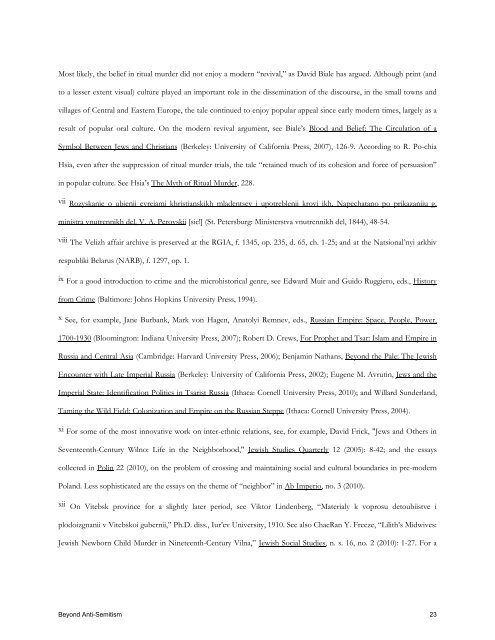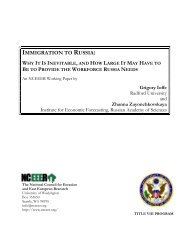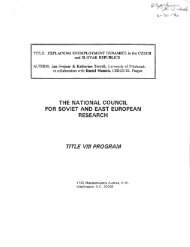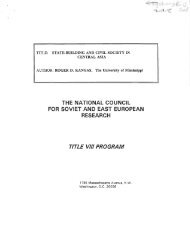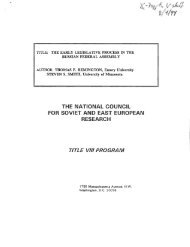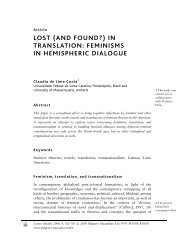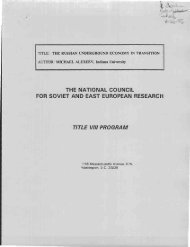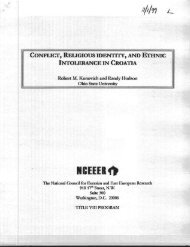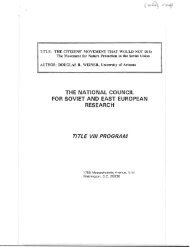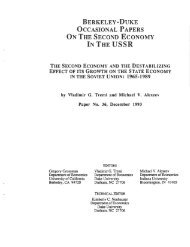Paper - University Center for International Studies
Paper - University Center for International Studies
Paper - University Center for International Studies
You also want an ePaper? Increase the reach of your titles
YUMPU automatically turns print PDFs into web optimized ePapers that Google loves.
Most likely, the belief in ritual murder did not enjoy a modern “revival,” as David Biale has argued. Although print (and<br />
to a lesser extent visual) culture played an important role in the dissemination of the discourse, in the small towns and<br />
villages of Central and Eastern Europe, the tale continued to enjoy popular appeal since early modern times, largely as a<br />
result of popular oral culture. On the modern revival argument, see Biale’s Blood and Belief: The Circulation of a<br />
Symbol Between Jews and Christians (Berkeley: <strong>University</strong> of Cali<strong>for</strong>nia Press, 2007), 126-9. According to R. Po-chia<br />
Hsia, even after the suppression of ritual murder trials, the tale “retained much of its cohesion and <strong>for</strong>ce of persuasion”<br />
in popular culture. See Hsia’s The Myth of Ritual Murder, 228.<br />
vii Rozyskanie o ubienii evreiami khristianskikh mladentsev i upotreblenii krovi ikh. Napechatano po prikazaniiu g.<br />
ministra vnutrennikh del, V. A. Perovskii [sic!] (St. Petersburg: Ministerstva vnutrennikh del, 1844), 48-54.<br />
viii The Velizh affair archive is preserved at the RGIA, f. 1345, op. 235, d. 65, ch. 1-25; and at the Natsional’nyi arkhiv<br />
respubliki Belarus (NARB), f. 1297, op. 1.<br />
ix For a good introduction to crime and the microhistorical genre, see Edward Muir and Guido Ruggiero, eds., History<br />
from Crime (Baltimore: Johns Hopkins <strong>University</strong> Press, 1994).<br />
x See, <strong>for</strong> example, Jane Burbank, Mark von Hagen, Anatolyi Remnev, eds., Russian Empire: Space, People, Power,<br />
1700-1930 (Bloomington: Indiana <strong>University</strong> Press, 2007); Robert D. Crews, For Prophet and Tsar: Islam and Empire in<br />
Russia and Central Asia (Cambridge: Harvard <strong>University</strong> Press, 2006); Benjamin Nathans, Beyond the Pale: The Jewish<br />
Encounter with Late Imperial Russia (Berkeley: <strong>University</strong> of Cali<strong>for</strong>nia Press, 2002); Eugene M. Avrutin, Jews and the<br />
Imperial State: Identification Politics in Tsarist Russia (Ithaca: Cornell <strong>University</strong> Press, 2010); and Willard Sunderland,<br />
Taming the Wild Field: Colonization and Empire on the Russian Steppe (Ithaca: Cornell <strong>University</strong> Press, 2004).<br />
xi For some of the most innovative work on inter-ethnic relations, see, <strong>for</strong> example, David Frick, "Jews and Others in<br />
Seventeenth-Century Wilno: Life in the Neighborhood," Jewish <strong>Studies</strong> Quarterly 12 (2005): 8-42; and the essays<br />
collected in Polin 22 (2010), on the problem of crossing and maintaining social and cultural boundaries in pre-modern<br />
Poland. Less sophisticated are the essays on the theme of “neighbor” in Ab Imperio, no. 3 (2010).<br />
xii On Vitebsk province <strong>for</strong> a slightly later period, see Viktor Lindenberg, “Materialy k voprosu detoubiistve i<br />
plodoizgnanii v Vitebskoi gubernii,” Ph.D. diss., Iur’ev <strong>University</strong>, 1910. See also ChaeRan Y. Freeze, “Lilith’s Midwives:<br />
Jewish Newborn Child Murder in Nineteenth-Century Vilna,” Jewish Social <strong>Studies</strong>, n. s. 16, no. 2 (2010): 1-27. For a<br />
Beyond Anti-Semitism 23


